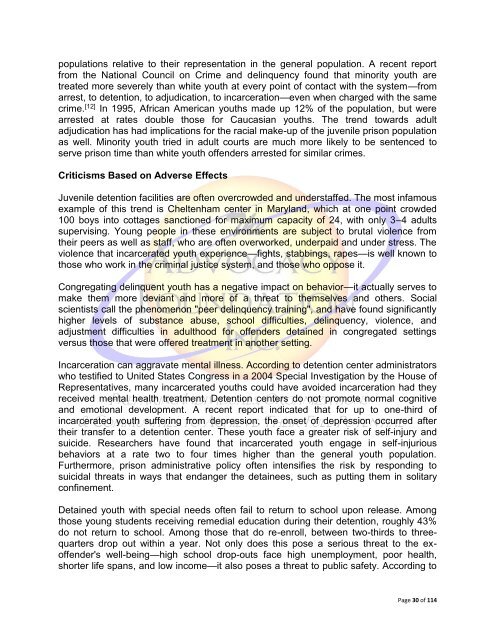African-American Youth in The Juvenile Justice System
African-American Youth in The Juvenile Justice System
African-American Youth in The Juvenile Justice System
You also want an ePaper? Increase the reach of your titles
YUMPU automatically turns print PDFs into web optimized ePapers that Google loves.
populations relative to their representation <strong>in</strong> the general population. A recent report<br />
from the National Council on Crime and del<strong>in</strong>quency found that m<strong>in</strong>ority youth are<br />
treated more severely than white youth at every po<strong>in</strong>t of contact with the system—from<br />
arrest, to detention, to adjudication, to <strong>in</strong>carceration—even when charged with the same<br />
crime. [12] In 1995, <strong>African</strong> <strong>American</strong> youths made up 12% of the population, but were<br />
arrested at rates double those for Caucasian youths. <strong>The</strong> trend towards adult<br />
adjudication has had implications for the racial make-up of the juvenile prison population<br />
as well. M<strong>in</strong>ority youth tried <strong>in</strong> adult courts are much more likely to be sentenced to<br />
serve prison time than white youth offenders arrested for similar crimes.<br />
Criticisms Based on Adverse Effects<br />
<strong>Juvenile</strong> detention facilities are often overcrowded and understaffed. <strong>The</strong> most <strong>in</strong>famous<br />
example of this trend is Cheltenham center <strong>in</strong> Maryland, which at one po<strong>in</strong>t crowded<br />
100 boys <strong>in</strong>to cottages sanctioned for maximum capacity of 24, with only 3–4 adults<br />
supervis<strong>in</strong>g. Young people <strong>in</strong> these environments are subject to brutal violence from<br />
their peers as well as staff, who are often overworked, underpaid and under stress. <strong>The</strong><br />
violence that <strong>in</strong>carcerated youth experience—fights, stabb<strong>in</strong>gs, rapes—is well known to<br />
those who work <strong>in</strong> the crim<strong>in</strong>al justice system, and those who oppose it.<br />
Congregat<strong>in</strong>g del<strong>in</strong>quent youth has a negative impact on behavior—it actually serves to<br />
make them more deviant and more of a threat to themselves and others. Social<br />
scientists call the phenomenon "peer del<strong>in</strong>quency tra<strong>in</strong><strong>in</strong>g", and have found significantly<br />
higher levels of substance abuse, school difficulties, del<strong>in</strong>quency, violence, and<br />
adjustment difficulties <strong>in</strong> adulthood for offenders deta<strong>in</strong>ed <strong>in</strong> congregated sett<strong>in</strong>gs<br />
versus those that were offered treatment <strong>in</strong> another sett<strong>in</strong>g.<br />
Incarceration can aggravate mental illness. Accord<strong>in</strong>g to detention center adm<strong>in</strong>istrators<br />
who testified to United States Congress <strong>in</strong> a 2004 Special Investigation by the House of<br />
Representatives, many <strong>in</strong>carcerated youths could have avoided <strong>in</strong>carceration had they<br />
received mental health treatment. Detention centers do not promote normal cognitive<br />
and emotional development. A recent report <strong>in</strong>dicated that for up to one-third of<br />
<strong>in</strong>carcerated youth suffer<strong>in</strong>g from depression, the onset of depression occurred after<br />
their transfer to a detention center. <strong>The</strong>se youth face a greater risk of self-<strong>in</strong>jury and<br />
suicide. Researchers have found that <strong>in</strong>carcerated youth engage <strong>in</strong> self-<strong>in</strong>jurious<br />
behaviors at a rate two to four times higher than the general youth population.<br />
Furthermore, prison adm<strong>in</strong>istrative policy often <strong>in</strong>tensifies the risk by respond<strong>in</strong>g to<br />
suicidal threats <strong>in</strong> ways that endanger the deta<strong>in</strong>ees, such as putt<strong>in</strong>g them <strong>in</strong> solitary<br />
conf<strong>in</strong>ement.<br />
Deta<strong>in</strong>ed youth with special needs often fail to return to school upon release. Among<br />
those young students receiv<strong>in</strong>g remedial education dur<strong>in</strong>g their detention, roughly 43%<br />
do not return to school. Among those that do re-enroll, between two-thirds to threequarters<br />
drop out with<strong>in</strong> a year. Not only does this pose a serious threat to the exoffender's<br />
well-be<strong>in</strong>g—high school drop-outs face high unemployment, poor health,<br />
shorter life spans, and low <strong>in</strong>come—it also poses a threat to public safety. Accord<strong>in</strong>g to<br />
Page 30 of 114

















